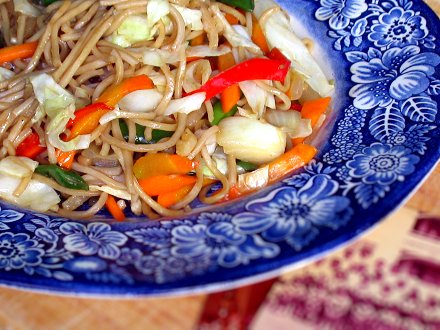
When my cousin Tingtong was seven, his mother took it upon herself to introduce him to proper pancit. This was after she discovered that we were regularly gorging on pancit sold at the rear of the town plaza where Terê and Titang held court over their ramshackle food emporia, cajoling kids to part with their five- and ten- and twenty-five-centavo coins in exchange for neon-colored biscuits, sticky candies, boiled bananas — and, of course, pancit, which was the house special and thoroughly enjoyed by all.*
Looking back, I can not quite imagine that we cousins had never been introduced to pancit prior to grade school, but there you go. I have to say, though: Na Terê made good pancit (Na Titang not so much), and I was more than a little puzzled about Tita’s objections to it, viz that it was nothing more than noodles doused in soy sauce with an occasional slice of fatty pork and two strips of cabbage thrown in (maybe, but it was still delicious); that it came wrapped in a cone made from Manila paper, and who knew which mahjongg table that paper had graced in its former life, or, indeed, what manner of matter was in it, given that you could not see what it really contained in the first place (true, but the paper we did not eat, and what we did was still delicious); that it was anyone’s guess what these people put in their food to make them so attractive to kids (this had more to do with Na Titang, ancient even then, who was widely rumored to be a witch and thus in possession of “secret” ingredients); that… (here Tita shuddered) basta!
Hence the arranged introduction. I was not privy to the details of the preparation, but I knew exactly what happened when my cousin went home and sat down for lunch that fateful day. A teary-eyed Tita Meling came over from next door to report that Tingtong… well, he refused to touch her pancit — just scrunched up his nose and wouldn’t even taste it. Imagine! she wailed. It wasn’t just any pancit, too, but the kind her sainted mother, our lola, was known for! For that to be passed over for Na Terê’s version… Ginoo, whoever heard of such outrage?
And so it came to pass that at at such a young and tender age did my cousin break his mother’s heart by scorning her for another woman’s cooking. To be honest, I would have done the same. What did we know about the finer points of pancit then? Absolutely zip, that’s what. If Na Terê’s was good enough then surely there was something going for it, which, now that I think about it, was its simplicity: noodles, soy sauce and MSG for flavor, some token meat and veggies, and broth. Compare it with the kind served at home, with all those vegetables to navigate and pick around before you got to the noodles, which was the only part worth eating.

You thought adults would know better, having been kids themselves once upon a time. You expected a measure of understanding. Instead you were harangued about the starving children in Africa or whatever armpit of the world was currently in crisis, prompting a vision of kids wasting away before bowls piled high with vegetables. Little wonder, you thought. I would be starving if I were served that slop, too. Then the lecture would segue into the fate that befell the souls of “bad” kids, i.e., those who refused to eat every last morsel on their plates. And you were making Jesus cry, willful child that you were. Like Jesus had to contend with vegetables, when all he ate were lamb, fish, and bread. We knew our Scripture, too.
Then, as now, grown-ups just didn’t get it: you don’t berate/threaten kids into eating their greens, or try to impress them with health and nutrition facts when the healthy and nutritious parts of the food are also the least appetizing. To win that uphill battle you have to employ a bit of… deceit. Like literally hiding the food, for instance. Terê and Titang were good at it, even as they used Manila paper to conceal the lack (rather than the presence) of vegetables in their noodles. Still, whatever vegetables presumably made their way through those cones and into my mouth were probably more than what my mother stared me down into eating during that same period. Plus I gladly paid for the experience.
I have since come a long way from being that child. Since then I have discovered many things about myself, perhaps the most unsettling of which is that I have grown up to be just like my parents. Sometimes I catch myself saying something and realize, Damn, I sound like Ma! I get in a snit over a poorly prepared dish and have to remind myself that it is precisely the sort of thing that I hate seeing my father do. I raise a big to-do when my niece opens a can of Holiday/Fiesta beef loaf when there’s perfectly palatable food on the table, until my mother reminds me about my childhood dietary quirks and the grief that brought her. I thumb my nose at this or that pancit: too salty, too bland, too oily, too soggy, too dry, not enough vegetables. Ha! Ma would give me this look. Excuse me, she would say, would you happen to know what became of that kid who loved Terê’s pancit so much?
This post has no comments.
Post a Comment